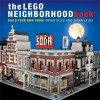JustJon Online
Lego

Review: Steampunk LEGO
In the 1980’s, Steampunk was developed as a reaction to the growing Cyberpunk movement. Rather than the dystopian future fiction that was being developed, a reactionary fiction wherein the Industrial Revolution never came to pass and culture became stuck in the Victorian Era and all machines were steam powered. With time, the Steampunk movement grew and art and costumers created their own interpretations, including LEGO builders. In the new book Steampunk LEGO, Guy Himber shows off some of the Steampunk LEGO creations.

Review: The Art of LEGO MINDSTORMS EV3 Programming
Many Mindstorms books teach how to use the kit by teaching how to make particular robots which work in a particular way. While this is a good way to learn how to build a Mindstorms robot, it is limiting the kinds of robots you learn to build and how the knowledge can be applied beyond those limited projects. Alternatively, there is The Art of LEGO MINDSTORMS EV3 Programming, a book focused primarily on the actual programming of the Mindstorms EV3 rather than overall robots.

Review: The LEGO MINDSTORMS EV3 Idea Book
Sometimes the hardest part of any project is getting started. Whether it is getting the initial idea or just getting started implementing the idea, it takes that effort to launch the concept into an actual project. For LEGO Mindstorms builders, The LEGO MINDSTORMS EV3 Idea Book is here to help bring that initial idea from concept to actual build.

Review: Beautiful LEGO 2: Dark
Over the years, the LEGO brick has moved from just a child’s plaything to an artistic medium. Like with other mediums, artist explore different aspects, including the darker ones that aren’t necessarily as wholesome as one would expect to find in children’s toys. With the new No Starch book, Beautiful LEGO 2: Dark, Mike Doyle explores some of the darker ideas that people have brought forth using LEGO pieces.

Review: The Art of the Brick: A Life in LEGO
In 2004, it was national news when lawyer Nathan Sawaya left his six figure lawyer job to become a LEGO Master Builder. Six months later, he left that job to become an independent LEGO builder and start creating art. Ten years later, his brick art travels the country in exhibits and recently a book of his exhibit was released by No Starch Press – The Art of the Brick: A Life in LEGO.

Review: The LEGO Neighborhood Book
LEGO has always been known for their towns and buildings buildings. Within the last decade, they began creating more complex buildings like the Cafe Corner, the Green Grocer and the Fire Brigade, which were built around a standard that became known as Modulars, and were able to be put together to create more complex towns and cityscapes. With The LEGO Neighborhood Book by Brian Lyles and Jason Lyles, readers are given an introduction to the standard and instructions to build their own original modulars.

Bionicle Returns at NYCC
For kids who grew up in the 2000’s a staple toy was LEGO’s Bionicle line of buildable and posable large figurines. From 2001 – 2009, the Technic based figures were fairly ubiquitous among boys’ toys, until the line was shut down due to dwindling interest. The fans of Bionicle have remained vocal for the past 5 years, and now LEGO has brought back the theme to the joy of its continuing fans.

The LEGO Super Friends Project
When the LEGO Friends line was introduced, it was met with mixed reviews. Many little girls loved it and LEGO builders liked the colors that were introduced with the line, but it was often derided for its more doll-like minifigures and its conformation to female stereotypes. It was such discussions, and the desire to utilize the same figures in order to the break the stereotypes that they had been assigned, that led me to start the LEGO Super Friends Project.

Review: The LEGO Adventure Book Volume 2
Megan Rothrock is a former LEGO designer, and current freelance toy designer, who obviously knows her way around the ABS brick. She returns to write a second volume of The LEGO Adventure Book, which brings back her advanced building techniques for younger readers. The second volume of The LEGO Adventure Book again uses a comic book layout […]

Review: The Art Of LEGO Design
As LEGO has advanced, so has the artistry in the building techniques of its fans. As The LEGO Group has introduced smaller and more versatile parts to work with, LEGO builders have established new and more interesting techniques for building with these new parts. Unfortunately for newer builders, it can be daunting to figure out these techniques, but The Art of LEGO Design by Jordan Schwartz is here to show builders how to make the most out of their LEGO parts.